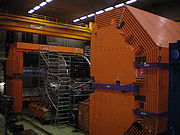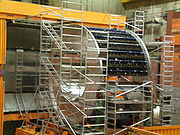.gif)
Zeus (particle detector)
Encyclopedia

Particle detector
In experimental and applied particle physics, nuclear physics, and nuclear engineering, a particle detector, also known as a radiation detector, is a device used to detect, track, and/or identify high-energy particles, such as those produced by nuclear decay, cosmic radiation, or reactions in a...
that operated on the HERA
Hadron Elektron Ring Anlage
HERA was a particle accelerator at DESY in Hamburg. It began operating in 1992. At HERA, electrons or positrons were collided with protons at a center of mass energy of 318 GeV. It was the only lepton-proton collider in the world while operating...
(Hadron Elektron Ring Anlage) particle accelerator at DESY
DESY
The DESY is the biggest German research center for particle physics, with sites in Hamburg and Zeuthen....
, Hamburg
Hamburg
-History:The first historic name for the city was, according to Claudius Ptolemy's reports, Treva.But the city takes its modern name, Hamburg, from the first permanent building on the site, a castle whose construction was ordered by the Emperor Charlemagne in AD 808...
. It began running together with HERA in 1992 and was functional until HERA was decommissioned in June 2007. The scientific collaboration behind ZEUS consisted of about 400 physicist
Physicist
A physicist is a scientist who studies or practices physics. Physicists study a wide range of physical phenomena in many branches of physics spanning all length scales: from sub-atomic particles of which all ordinary matter is made to the behavior of the material Universe as a whole...
s from 56 institute
Institute
An institute is a permanent organizational body created for a certain purpose. Often it is a research organization created to do research on specific topics...
s in 17 countries
Country
A country is a region legally identified as a distinct entity in political geography. A country may be an independent sovereign state or one that is occupied by another state, as a non-sovereign or formerly sovereign political division, or a geographic region associated with a previously...
.
The ZEUS detector comprised many components, including a depleted uranium
Depleted uranium
Depleted uranium is uranium with a lower content of the fissile isotope U-235 than natural uranium . Uses of DU take advantage of its very high density of 19.1 g/cm3...
plastic-scintillator
Scintillator
A scintillator is a special material, which exhibits scintillation—the property of luminescence when excited by ionizing radiation. Luminescent materials, when struck by an incoming particle, absorb its energy and scintillate, i.e., reemit the absorbed energy in the form of light...
calorimeter
Calorimeter
A calorimeter is a device used for calorimetry, the science of measuring the heat of chemical reactions or physical changes as well as heat capacity. Differential scanning calorimeters, isothermal microcalorimeters, titration calorimeters and accelerated rate calorimeters are among the most common...
, a central tracking detector (which is a wire chamber
Wire chamber
A multi-wire chamber is a detector for particles of ionizing radiation which is an advancement of the concept of the Geiger counter and the proportional counter....
), a silicon
Silicon
Silicon is a chemical element with the symbol Si and atomic number 14. A tetravalent metalloid, it is less reactive than its chemical analog carbon, the nonmetal directly above it in the periodic table, but more reactive than germanium, the metalloid directly below it in the table...
microvertex detector and muon chambers. In addition, a solenoid
Solenoid
A solenoid is a coil wound into a tightly packed helix. In physics, the term solenoid refers to a long, thin loop of wire, often wrapped around a metallic core, which produces a magnetic field when an electric current is passed through it. Solenoids are important because they can create...
provides a magnetic field
Magnetic field
A magnetic field is a mathematical description of the magnetic influence of electric currents and magnetic materials. The magnetic field at any given point is specified by both a direction and a magnitude ; as such it is a vector field.Technically, a magnetic field is a pseudo vector;...
.
The ZEUS experiment studied the internal structure of the proton
Proton
The proton is a subatomic particle with the symbol or and a positive electric charge of 1 elementary charge. One or more protons are present in the nucleus of each atom, along with neutrons. The number of protons in each atom is its atomic number....
through measurements of deep inelastic scattering
Deep Inelastic Scattering
Deep inelastic scattering is the name given to a process used to probe the insides of hadrons , using electrons, muons and neutrinos. It provided the first convincing evidence of the reality of quarks, which up until that point had been considered by many to be a purely mathematical phenomenon...
by colliding leptons (electron
Electron
The electron is a subatomic particle with a negative elementary electric charge. It has no known components or substructure; in other words, it is generally thought to be an elementary particle. An electron has a mass that is approximately 1/1836 that of the proton...
s or positron
Positron
The positron or antielectron is the antiparticle or the antimatter counterpart of the electron. The positron has an electric charge of +1e, a spin of ½, and has the same mass as an electron...
s) with proton
Proton
The proton is a subatomic particle with the symbol or and a positive electric charge of 1 elementary charge. One or more protons are present in the nucleus of each atom, along with neutrons. The number of protons in each atom is its atomic number....
in the interaction point
Interaction point
In particle physics, an interaction point is the place where particles collide. One differentiates between the nominal IP, which is the design position of the IP, and the real or physics IP, which is the position where the particles actually collide...
of ZEUS. These measurements were also used to test and study the Standard Model
Standard Model
The Standard Model of particle physics is a theory concerning the electromagnetic, weak, and strong nuclear interactions, which mediate the dynamics of the known subatomic particles. Developed throughout the mid to late 20th century, the current formulation was finalized in the mid 1970s upon...
of particle physics
Particle physics
Particle physics is a branch of physics that studies the existence and interactions of particles that are the constituents of what is usually referred to as matter or radiation. In current understanding, particles are excitations of quantum fields and interact following their dynamics...
, as well as searching for particles beyond the Standard Model.
Background
DESYDESY
The DESY is the biggest German research center for particle physics, with sites in Hamburg and Zeuthen....
was founded in 1959 and started colliding electron beams in 1964 in the DESY experiment. Since then, it has been a highly regarded center for particle physics
Particle physics
Particle physics is a branch of physics that studies the existence and interactions of particles that are the constituents of what is usually referred to as matter or radiation. In current understanding, particles are excitations of quantum fields and interact following their dynamics...
. The design effort for ZEUS can be traced back to 1982, a Letter of Intent was submitted in 1985,
and the HERA collider began operation in 1992. The last electron–proton collisions at ZEUS were recorded on 30 June 2007.
Detector

The purpose of the ZEUS detector was to collect data to allow the reconstruction of physics events in a consistent way so they can be analyzed.
Calorimeter

Calorimeter (particle physics)
In particle physics, a calorimeter is an experimental apparatus that measures the energy of particles. Most particles enter the calorimeter and initiate a particle shower and the particles' energy is deposited in the calorimeter, collected, and measured. The energy may be measured in its...
was a uranium
Uranium
Uranium is a silvery-white metallic chemical element in the actinide series of the periodic table, with atomic number 92. It is assigned the chemical symbol U. A uranium atom has 92 protons and 92 electrons, of which 6 are valence electrons...
scintillator
Scintillator
A scintillator is a special material, which exhibits scintillation—the property of luminescence when excited by ionizing radiation. Luminescent materials, when struck by an incoming particle, absorb its energy and scintillate, i.e., reemit the absorbed energy in the form of light...
based sampling calorimeter
Calorimeter
A calorimeter is a device used for calorimetry, the science of measuring the heat of chemical reactions or physical changes as well as heat capacity. Differential scanning calorimeters, isothermal microcalorimeters, titration calorimeters and accelerated rate calorimeters are among the most common...
and divided into 3 main sections: the BCAL (Barrel CALorimeter), FCAL (Forward CALorimeter), and RCAL (Rear CALorimeter). Each section was subdivided transversely into towers, and longitudinally into EMC (Electro-Magnetic Calorimeter) or HAC (HAdronic Calorimeter). The smallest subdivision in the calorimeter was called a cell. Each cell was read-out by two photomultiplier tubes
Photomultiplier
Photomultiplier tubes , members of the class of vacuum tubes, and more specifically phototubes, are extremely sensitive detectors of light in the ultraviolet, visible, and near-infrared ranges of the electromagnetic spectrum...
(PMT), which helped ensure that there were no holes in the coverage if one of the two PMTs failed.
Uranium was chosen as an absorber so that the calorimeter
Calorimeter
A calorimeter is a device used for calorimetry, the science of measuring the heat of chemical reactions or physical changes as well as heat capacity. Differential scanning calorimeters, isothermal microcalorimeters, titration calorimeters and accelerated rate calorimeters are among the most common...
would be compensating. Electrons and photon
Photon
In physics, a photon is an elementary particle, the quantum of the electromagnetic interaction and the basic unit of light and all other forms of electromagnetic radiation. It is also the force carrier for the electromagnetic force...
s deposit energy differently from hadron
Hadron
In particle physics, a hadron is a composite particle made of quarks held together by the strong force...
s, but in a compensating calorimeter
Calorimeter
A calorimeter is a device used for calorimetry, the science of measuring the heat of chemical reactions or physical changes as well as heat capacity. Differential scanning calorimeters, isothermal microcalorimeters, titration calorimeters and accelerated rate calorimeters are among the most common...
the response (e) for an electromagnetic cascade is equal to the response (h) for a hadronic cascade of the same energy, i.e. e/h=1. In the ZEUS calorimeter neutral pions
Pion
In particle physics, a pion is any of three subatomic particles: , , and . Pions are the lightest mesons and they play an important role in explaining the low-energy properties of the strong nuclear force....
interacted with uranium atoms to produce slow moving neutron
Neutron
The neutron is a subatomic hadron particle which has the symbol or , no net electric charge and a mass slightly larger than that of a proton. With the exception of hydrogen, nuclei of atoms consist of protons and neutrons, which are therefore collectively referred to as nucleons. The number of...
s which were captured by the scintillator and increased the hadronic signal. Another advantage of using uranium as the absorber was that the natural radioactivity allowed the calorimeter's sensitivity to be conveniently monitored.

